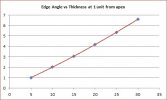Ankerson
Knife and Computer Geek
- Joined
- Nov 2, 2002
- Messages
- 21,094
Been waiting to do this one until I got more rope in and for things to calm down some. 
This is the same method as I use in my Edge retention thread, but with coarse edges so the smaller differences will show up, it's good for head to head comparisons. I cut until I reached 20 LBS of down force on 5/8" Manila rope, both knives are Military's and 15 DPS, edge finish was 400 grit silicone carbide mold master stone.
Both knives have been hardness tested:
CTS XHP - 60 HRC
CPM S30V - 60 HRC
Steel information:
CPM S30V
Carbon 1.45%
Chromium 14.00 %
Vanadium 4.0%
Molybdenum 2.0%
CTS XHP
Carbon 1.65%
Chromium 16.00%
Molybdenum 0.80%
Silicon 0.40%
Manganese 0.50%
Vanadium 0.45%
Nickel 0.35%
First up was CTS XHP




Next was CPM S30V



And the knives together.

Test results and conclusions:
CTS XHP did very well and cut very aggressively on the rope with the edge tested and suffered very little edge damage with a few small shiny spots on the edge. The edge would still slice printer paper easy after the testing.
CPM S30V also did very well and was aggressive with the edge tested and had very slight edge damage with a shiny spot. The knife would cut printer paper easy after testing.
Results:
CTS XHP - 240 cuts
CPM S30V - 300 cuts
The Vanadium in the S30V took over and and caused it to perform better than XHP in this test.
Other numbers using the same method, edge finish and edge geometry also using the same model knives, the Military, for comparison only to show higher wear resistant steels.
M390 (61 HRC) - 380 Cuts
CPM S90V (60 HRC) - 460 Cuts
This is the same method as I use in my Edge retention thread, but with coarse edges so the smaller differences will show up, it's good for head to head comparisons. I cut until I reached 20 LBS of down force on 5/8" Manila rope, both knives are Military's and 15 DPS, edge finish was 400 grit silicone carbide mold master stone.
Both knives have been hardness tested:
CTS XHP - 60 HRC
CPM S30V - 60 HRC
Steel information:
CPM S30V
Carbon 1.45%
Chromium 14.00 %
Vanadium 4.0%
Molybdenum 2.0%
CTS XHP
Carbon 1.65%
Chromium 16.00%
Molybdenum 0.80%
Silicon 0.40%
Manganese 0.50%
Vanadium 0.45%
Nickel 0.35%
First up was CTS XHP
Next was CPM S30V
And the knives together.
Test results and conclusions:
CTS XHP did very well and cut very aggressively on the rope with the edge tested and suffered very little edge damage with a few small shiny spots on the edge. The edge would still slice printer paper easy after the testing.
CPM S30V also did very well and was aggressive with the edge tested and had very slight edge damage with a shiny spot. The knife would cut printer paper easy after testing.
Results:
CTS XHP - 240 cuts
CPM S30V - 300 cuts
The Vanadium in the S30V took over and and caused it to perform better than XHP in this test.
Other numbers using the same method, edge finish and edge geometry also using the same model knives, the Military, for comparison only to show higher wear resistant steels.
M390 (61 HRC) - 380 Cuts
CPM S90V (60 HRC) - 460 Cuts

